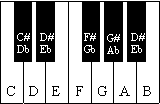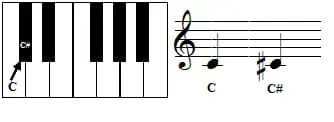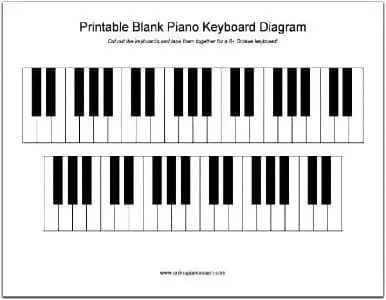- Home
- Adult Beginner Piano Lessons
- Piano Keyboard Diagram
Printable Piano Keyboard Diagram
This article may contain compensated links. Please read the disclosure for more info.
In this lesson, you can print piano keyboard diagram templates for free and learn all the note names quickly and easily on the piano keys.
The templates are helpful tools when you first start to learn how to play piano, so you will not get lost among all the piano keys!
But keep on reading, and you may no longer need it by the end of this piano lesson! :)
The Piano Keyboard Diagram: How Many Keys Are There Actually?
Did you know that:
- Piano keyboards exist in many different sizes and with varying numbers of keys.
- A full-sized regular piano keyboard has 88 keys.
- Other electronic piano keyboards can have almost any number of keys.
- When buying a piano or keyboard, it is good to remember that many piano pieces are not playable on keyboards with fewer than 88 keys...!

Tip: As you start to learn how to play the piano, you can also use a Piano Keyboard & Note Chart like this for placing behind the keys.
What are the 12 Keys on a Piano?
 Piano Notes Diagram
Piano Notes DiagramIn the music of the western tradition, there are 12 different notes:
7 are the Basic Notes, labeled after the first 7 letters in the alphabet; A, B, C, D, E, F, and G. These are also the white keys.
5 are Altered Notes, a semitone/half step higher or lower from the basic notes. These are the black keys on a piano.
On the piano keyboard layout, this can be observed in the pattern of the white and black keys. So, the piano keyboard has only 12 different keys; 7 white and 5 black keys. The rest of the keys are repeated with either higher or lower pitch.
>>> Click here for a popular online piano method for beginners.
How is a piano keyboard laid out?
Piano Key Notes
Here is a piano keyboard diagram with the note names of the white keys or the basic notes:
 Piano Notes Diagram White Keys
Piano Notes Diagram White KeysYou can see that the 7 basic notes (A B C D E F G) are repeated over and over. But each time they repeat, the music pitch (how high or low the tone is) sounds one octave higher (if you play to the right on the keyboard).
An octave is the distance, or music interval, from one note or tone to the next with the same name, higher or lower.
You can also see that all keys have a black key between them except between E - F and B - C.
All steps (the interval from one key to the next) having a black key between them are called whole steps or tones. Those that don’t, E-F and B-C, are smaller and called semitones or half steps.
There are also half steps/semitones between a black and the white key next to it or reversed. And there are whole steps from one black key to the next with a white key between.
Black Key Patterns
Let's look at how the black keys are grouped in two's and three's all over the keyboard. Recognizing this repeated pattern also makes finding our way on the piano easier.
Look at this piano keyboard diagram where the black key groups are circled:

The black keys make it possible to play many more scales and melodies. They fill in the “gap” where there are whole steps, so to speak!
By playing all the keys one after the other, both the white and the black keys, next to each other, you can play a chromatic scale. A chromatic scale is made from only half steps or semitones.
Naming the Black Keys - Accidentals
The black keys are named after the white right next to them. They are alterations of the white keys.
The black keys have two names. The name depends on the white key it started from, the one above or below.
So how do you alter a white key?
Easy, just use one of two music symbols; the sharp (♯) or the flat (♭). These symbols and the natural sign (♮) are called accidentals. (Nope- no accident!).
You will see accidentals written in the sheet music right before a note.
By the way: If you just mention a black key without reading any sheet music, it is OK to use any of the two names.
Let’s say you read the note C. If there is a sharp sign (♯) in front of C, you get to play the black key a half step higher (to the right) - Yay!

In the same way, you can use the flat sign (♭) to lower a note.
Starting from D this time, and imagine having a flat sign in front of that D; you will then instead play the black key a half step lower (to the left):

-Whoa, stop there! D♭ is the same key as C♯???
Yes, it is! The keys can have two names, depending on the accidentals. If they end up on the same key, they are called enharmonic ("one sounded").
You can use a sharp (♯) or flat (♭) symbol on any note. So even an E can have a sharp symbol… and where does it go? To F!
Since there is only a half step between E and F - and a sharp sign raises the note a half step - there is only F to go to. So E♯ and F are also enharmonic.
PS. If you read all this- you'll probably no longer need a piano keyboard diagram! :)
Piano Keyboard Diagram to Print
1. Blank Piano Keyboard Diagram
Here is a free printable blank piano keyboard diagram (click to open a printable PDF in a new window). You can, for example, practice by filling in the note names yourself.
2. Piano Key Chart with Note Names
Here is another piano keyboard diagram with all the note names (click to open a printable PDF in a new window). Print it on thicker paper, cut out the keyboards, and tape them together for a more extended piano keyboard. You can place this behind the keys as you start learning.
Recommended Resources
- Piano Keyboard & Note Chart for Behind the Keys
- Now Anyone Can Learn How to Play Piano or Keyboard
- Keyboard Stickers with Note Names







